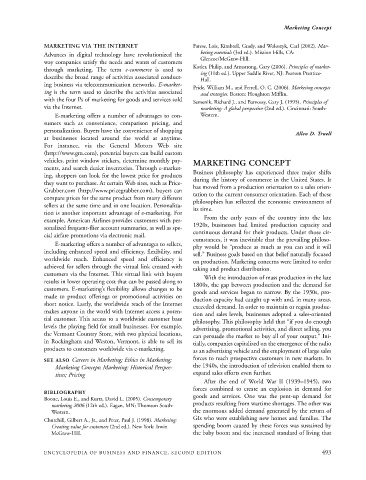Page 516 - Encyclopedia of Business and Finance
P. 516
eobf_M 7/5/06 3:15 PM Page 493
Marketing Concept
MARKETING VIA THE INTERNET Farese, Lois, Kimbrell, Grady, and Woloszyk, Carl (2002). Mar-
Advances in digital technology have revolutionized the keting essentials (3rd ed.). Mission Hills, CA:
Glencoe/McGraw-Hill.
way companies satisfy the needs and wants of customers
through marketing. The term e-commerce is used to Kotler, Philip, and Armstrong, Gary (2006). Principles of market-
ing (11th ed.). Upper Saddle River, NJ: Pearson Prentice-
describe the broad range of activities associated conduct-
Hall.
ing business via telecommunication networks. E-market-
Pride, William M., and Ferrell, O. C. (2006). Marketing concepts
ing is the term used to describe the activities associated and strategies. Boston: Houghton Mifflin.
with the four Ps of marketing for goods and services sold
Semenik, Richard J., and Bamossy, Gary J. (1995). Principles of
via the Internet. marketing: A global perspective (2nd ed.). Cincinnati: South-
E-marketing offers a number of advantages to con- Western.
sumers such as convenience, comparison pricing, and
personalization. Buyers have the convenience of shopping
Allen D. Truell
at businesses located around the world at anytime.
For instance, via the General Motors Web site
(http://www.gm.com), potential buyers can build custom
vehicles, print window stickers, determine monthly pay- MARKETING CONCEPT
ments, and search dealer inventories. Through e-market-
Business philosophy has experienced three major shifts
ing, shoppers can look for the lowest price for products
they want to purchase. At certain Web sites, such as Price- during the history of commerce in the United States. It
has moved from a production orientation to a sales orien-
Grabber.com (http://www.pricegrabber.com), buyers can tation to the current consumer orientation. Each of these
compare prices for the same product from many different philosophies has reflected the economic environment of
sellers at the same time and in one location. Personaliza-
its time.
tion is another important advantage of e-marketing. For
From the early years of the country into the late
example, American Airlines provides customers with per-
1920s, businesses had limited production capacity and
sonalized frequent-flier account summaries, as well as spe-
continuous demand for their products. Under those cir-
cial airfare promotions via electronic mail.
cumstances, it was inevitable that the prevailing philoso-
E-marketing offers a number of advantages to sellers,
phy would be “produce as much as you can and it will
including enhanced speed and efficiency, flexibility, and sell.” Business goals based on that belief naturally focused
worldwide reach. Enhanced speed and efficiency is on production. Marketing concerns were limited to order
achieved for sellers through the virtual link created with taking and product distribution.
customers via the Internet. This virtual link with buyers
With the introduction of mass production in the late
results in lower operating cost that can be passed along to 1800s, the gap between production and the demand for
customers. E-marketing’s flexibility allows changes to be
goods and services began to narrow. By the 1930s, pro-
made to product offerings or promotional activities on
duction capacity had caught up with and, in many areas,
short notice. Lastly, the worldwide reach of the Internet
exceeded demand. In order to maintain or regain produc-
makes anyone in the world with Internet access a poten-
tion and sales levels, businesses adopted a sales-oriented
tial customer. This access to a worldwide customer base philosophy. This philosophy held that “if you do enough
levels the playing field for small businesses. For example, advertising, promotional activities, and direct selling, you
the Vermont Country Store, with two physical locations, can persuade the market to buy all of your output.” Ini-
in Rockingham and Weston, Vermont, is able to sell its
tially, companies capitalized on the emergence of the radio
products to customers worldwide via e-marketing. as an advertising vehicle and the employment of large sales
SEE ALSO Careers in Marketing; Ethics in Marketing; forces to reach prospective customers in new markets. In
Marketing Concept; Marketing: Historical Perspec- the 1940s, the introduction of television enabled them to
tives; Pricing expand sales efforts even further.
After the end of World War II (1939–1945), two
forces combined to create an explosion in demand for
BIBLIOGRAPHY
Boone, Louis E., and Kurtz, David L. (2005). Contemporary goods and services. One was the pent-up demand for
marketing 2006 (12th ed.). Eagan, MN: Thomson South- products resulting from wartime shortages. The other was
Western. the enormous added demand generated by the return of
Churchill, Gilbert A., Jr., and Peter, Paul J. (1998). Marketing: GIs who were establishing new homes and families. The
Creating value for customers (2nd ed.). New York: Irwin spending boom caused by these forces was sustained by
McGraw-Hill. the baby boom and the increased standard of living that
ENCYCLOPEDIA OF BUSINESS AND FINANCE, SECOND EDITION 493

